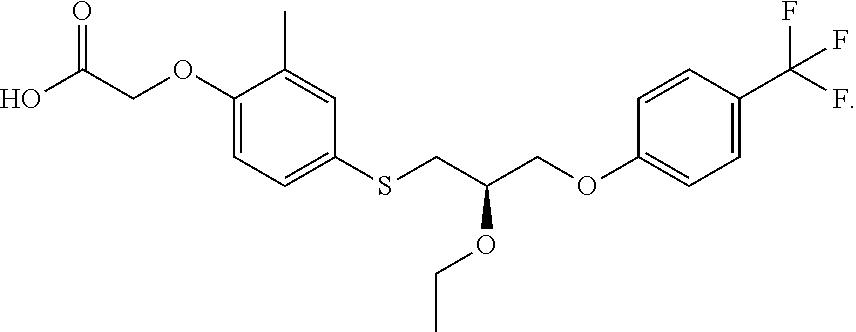Treatment of homozygous familial hypercholesterolemia
- Summary
- Abstract
- Description
- Claims
- Application Information
AI Technical Summary
Benefits of technology
Problems solved by technology
Method used
Image
Examples
example 1
Study with MBX-8025
[0068]Subjects with HoFH (diagnosed either by genetic testing or by an untreated LDL-C >500 mg / dL and early appearance of xanthoma or LDL-C levels consistent with HeFH in both parents), on maximally-tolerated lipid-lowering therapy, are treated with MBX-8025 L-lysine dihydrate salt at a dose of 50, 100, or 200 mg / day (as MBX-8025 free acid). Subjects are permitted their usual other medications, including lipid-lowering treatments. The subjects are assessed before the study, and at intervals during the study, such as every 4 weeks during the study and 4 weeks after the last dose of the MBX-8025 therapy, for safety and pharmacodynamic evaluations. MRIs of the subjects' livers are taken every 4 weeks during the study and 4 weeks after study completion, to determine hepatic fat. At each visit, after a 12-hour fast, blood is drawn and urine collected; and a standard metabolic panel, complete blood count, and standard urinalysis are performed. Blood is analyzed for TC, ...
example 2
Dose Escalation Study with MBX-8025 and Lomitapide
[0070]Subjects with HoFH(diagnosed either by genetic testing or by an untreated LDL-C >500 mg / dL and early appearance of xanthoma or LDL-C levels consistent with HeFH in both parents), on maximally-tolerated lipid-lowering therapy, are treated with MBX-8025 L-lysine dihydrate salt at a dose of 50, 100, or 200 mg / day (as MBX-8025 free acid) in combination with escalating doses of lomitapide (lomitapide mesylate doses of 5, 10, 20, 40, and 60 mg / day each for 4 weeks). The subjects are instructed to maintain a low-fat diet (<20% energy from fat) and to take dietary supplements that provide approximately 400 IU vitamin E, 210 mg α-linolenic acid, 200 mg linoleic acid, 110 mg eicosapentenoic acid, and 80 mg docosahexaenoic acid per day; and are permitted their usual other medications, although other lipid-lowering treatments are suspended. The subjects are assessed before the study, and at intervals during the study, such as every 1, 2, a...
example 3
Study with MBX-8025 and Mipomersen
[0072]Subjects with HoFH(diagnosed either by genetic testing or by an untreated LDL-C >500 mg / dL and early appearance of xanthoma or LDL-C levels consistent with HeFH in both parents), on maximally-tolerated lipid-lowering therapy, are treated with MBX-8025 L-lysine dihydrate salt at a dose of 50, 100, or 200 mg / day (as MBX-8025 free acid) in combination with mipomersen sodium doses of 200 mg / week (or 160 mg / week for subjects weighing less than 50 Kg). The subjects are instructed to maintain their usual diet and medications. The subjects are assessed before the study, and at intervals during the study, such as every 2 weeks for the first month, every 4 weeks thereafter, and 4 weeks after the last dose of the combination therapy, for safety and pharmacodynamic evaluations. MRIs of the subjects' livers are taken at baseline and 4 weeks after study completion, to determine hepatic fat. At each visit, after a 12-hour fast, blood is drawn and urine colle...
PUM
| Property | Measurement | Unit |
|---|---|---|
| Mass | aaaaa | aaaaa |
| Mass flow rate | aaaaa | aaaaa |
| Mass flow rate | aaaaa | aaaaa |
Abstract
Description
Claims
Application Information
 Login to View More
Login to View More - R&D
- Intellectual Property
- Life Sciences
- Materials
- Tech Scout
- Unparalleled Data Quality
- Higher Quality Content
- 60% Fewer Hallucinations
Browse by: Latest US Patents, China's latest patents, Technical Efficacy Thesaurus, Application Domain, Technology Topic, Popular Technical Reports.
© 2025 PatSnap. All rights reserved.Legal|Privacy policy|Modern Slavery Act Transparency Statement|Sitemap|About US| Contact US: help@patsnap.com


